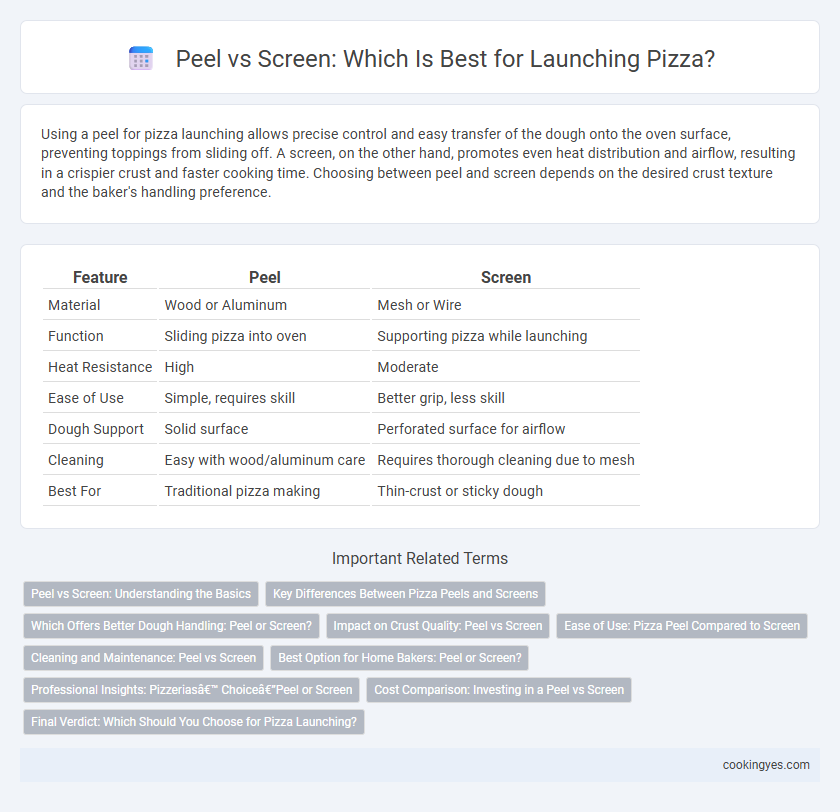Using a peel for pizza launching allows precise control and easy transfer of the dough onto the oven surface, preventing toppings from sliding off. A screen, on the other hand, promotes even heat distribution and airflow, resulting in a crispier crust and faster cooking time. Choosing between peel and screen depends on the desired crust texture and the baker's handling preference.
Table of Comparison
| Feature | Peel | Screen |
|---|---|---|
| Material | Wood or Aluminum | Mesh or Wire |
| Function | Sliding pizza into oven | Supporting pizza while launching |
| Heat Resistance | High | Moderate |
| Ease of Use | Simple, requires skill | Better grip, less skill |
| Dough Support | Solid surface | Perforated surface for airflow |
| Cleaning | Easy with wood/aluminum care | Requires thorough cleaning due to mesh |
| Best For | Traditional pizza making | Thin-crust or sticky dough |
Peel vs Screen: Understanding the Basics
A pizza peel is a traditional wooden or metal paddle used to transfer pizzas in and out of an oven, offering direct handling for precise placement and removal. A pizza screen, typically made of perforated aluminum, allows for increased airflow during baking, promoting a crispier crust by preventing moisture buildup. Understanding the basics of peel versus screen helps pizza-makers choose the right tool based on desired crust texture and ease of pizza launching.
Key Differences Between Pizza Peels and Screens
Pizza peels are flat, solid tools typically made from wood or metal, designed to slide under the pizza for easy transfer into and out of the oven, providing optimal support and preventing toppings from sliding off. Pizza screens, made from perforated metal mesh, allow for better heat circulation and a crispier crust by enabling hot air to evenly reach the bottom of the dough. The primary difference lies in their function: peels are best for launching and retrieving pizzas intact, while screens enhance baking quality by promoting even cooking and reducing sogginess.
Which Offers Better Dough Handling: Peel or Screen?
Peel and screen both play crucial roles in pizza launching, but peel offers superior dough handling due to its solid, flat surface that supports the dough evenly, preventing stretching or tearing. Screens, while useful for creating crisper crusts through improved air circulation, can cause dough to stick or deform, especially with softer or more hydrated doughs. For consistent dough handling and maintaining shape during launch, peel remains the preferred tool among pizzerias and professional bakers.
Impact on Crust Quality: Peel vs Screen
Using a pizza peel for launching ensures a crispier crust by allowing excess flour or cornmeal to fall away, preventing sogginess often caused by trapped moisture. In contrast, a screen promotes even heat circulation beneath the dough, resulting in a uniformly cooked crust but can sometimes retain moisture, leading to a slightly softer texture. Choosing between peel and screen directly influences crust texture, with peel favoring crispness and screen enhancing bake consistency.
Ease of Use: Pizza Peel Compared to Screen
Pizza peels offer superior ease of use compared to screens, featuring a flat, sturdy surface that allows effortless transfer of dough and toppings onto hot pizza stones or ovens. The solid wooden or metal construction provides better control and stability, reducing the risk of toppings sliding off during launch. In contrast, screens, often made from mesh metal, require more skill to maneuver and can complicate dough handling due to their less supportive surface.
Cleaning and Maintenance: Peel vs Screen
Peel cleaning requires regular scraping to remove baked-on dough and sauce residues, often needing soaking and manual scrubbing to maintain hygiene and performance. Screen cleaning benefits from its mesh design that allows easier debris removal through brushing and washing, reducing buildup and drying time. Consistent maintenance of both tools ensures optimal pizza launch quality, but screens typically offer a simpler cleaning process and quicker turnaround for busy pizzerias.
Best Option for Home Bakers: Peel or Screen?
A pizza peel offers precise control and ease when transferring homemade pizzas directly into a hot oven, making it the best option for home bakers who value quick and efficient launching. Pizza screens allow for better airflow and even cooking, ideal for those seeking a crispy crust without frequent oven checks. Home bakers typically prefer peels for their versatility and ability to handle various pizza styles with minimal preparation.
Professional Insights: Pizzerias’ Choice—Peel or Screen
Professional pizzerias often prefer a peel for pizza launching due to its versatility and traditional effectiveness in handling various crust types and sizes. Screens are favored for their ability to evenly distribute heat, resulting in a crispier crust, which appeals to Neapolitan-style pizza makers seeking consistency. Choosing between peel and screen largely depends on the pizzeria's oven type and desired crust texture, reflecting industry preferences for optimizing pizza quality and operational efficiency.
Cost Comparison: Investing in a Peel vs Screen
Investing in a pizza peel requires a lower upfront cost, typically ranging from $15 to $50, making it an affordable option for small pizzerias and home kitchens. Conversely, screen launchers can cost between $100 and $300, representing a higher investment but offering faster pizza launching and potentially increased kitchen efficiency. Over time, the durability and reduced maintenance of a quality peel may balance out costs compared to frequent screen replacements or repairs.
Final Verdict: Which Should You Choose for Pizza Launching?
Choosing between a peel and a screen for pizza launching depends on your specific needs and cooking style. A pizza peel offers traditional versatility and ease of handling, perfect for transferring dough onto hot oven surfaces, while a screen allows for better airflow, promoting a crispier crust and more even baking in home ovens or grills. For pizzerias aiming for consistent, high-quality results with minimal effort, the peel is usually the preferred tool, but home cooks seeking a crisp texture might favor the screen.
Peel vs Screen for pizza launching Infographic

 cookingyes.com
cookingyes.com